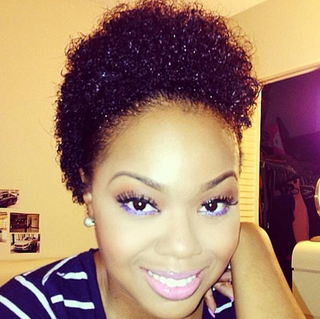So, you've decided to transition. You hope it will allow you to keep some of your length even if it's a slower process than the large chop. Of course, it is up to you to decide how long you want to transition; some people desire a very brief length of time and aim to chop off their processed curls within a few months, while others want to transition for as long as possible, which can be more difficult. Because the months ahead of you may be challenging, here is a list of the seven most straightforward techniques to make the transition to natural hair smoother.
Arm Yourself With The Right Haircare Tools
Save yourself some hassle by purchasing hair tools that make your transition to natural hair easier. To prevent your hair from breaking and becoming dry and brittle, the appropriate equipment includes silk pillows, bonnets, and scrunchies. In addition, your wash day would not be complete without a dependable detangling brush that functions as a wide-tooth comb. Be sure to start detangling from the bottom up rather than the top down. By making this change, you will reduce the risk of single-strand knots, which can occur when the hair shafts become twisted during the combing process.
In addition, using bonnets and pillows made of silk or satin while you sleep will help prevent damage to your hair. If you want to retain the moisture on your curls as you sleep, lightly spray Sofnfree’s Everyday Curl Refresh With Coconut & Jamaican Black Castor Oils on them.

Prioritise Scalp Health And Gentle Detangling
One ingredient that might cause your hair to become brittle, especially if you have a dry or sensitive scalp, is sulphates. Sulphates can remove moisture from your strands, making your curly hair look dry, especially if used too often. To stop this from happening, you should always examine the ingredients within your hair care products and avoid those that could be drying your hair.
Luckily, Sofnfree Hydration Shampoo With Manuka Honey is free from sulphates meaning that it gently cleanses your curly hair while sustaining normal moisture levels on your scalp. You can also practice gentle detangling in the shower using a wide-toothed comb from your ends to your roots with Sofnfree Moisture-Rich Conditioner With Manuka Honey and Avocado.
Tangles in your natural hair can cause your hair to break easily and prevent you from keeping its length. So, try sleeping with a silk or satin head wrap, twisting or braiding your hair at night, and pre-pooing it before cleansing it to help keep the knots at bay. All of these things can help you minimise breaking while you are in the process of transitioning.
Reduce Heat Styling And Schedule Your No-Heat Styles In Advance
It’s easy to go back to using heat-styling tools regularly if your hair is going through a difficult phase in the transitioning journey. It is fine if you only use heat occasionally, but if you do it all the time, it is not helping you feel more comfortable with your natural texture.

After you've washed and conditioned your curly hair, you should experiment with styling your natural hair without using heat. When going out for a special occasion or a night on the town, use a heat protectant before using a heat styling tool if you are applying heat to your hair. Alternatively, if you want to skip heat, opt for a double-strand twist-out using Sofnfree Curling Mousse With Flaxseed Oil & Rosewater, which can also provide hold and keep any necessary moisture within your curls.
Bantu knots and roller sets are also viable alternative styles that do not require heat. Both styles can naturally stretch your hair, keep the amount of manipulation to a minimum and leave you with a style you can wear for up to a week. Sofnfree Curl Elongating Gel With Flaxseed Oil & Rosewater can also help you elongate your curls.

Continue Trimming Your Curly Hair At Least Every Two Months
The ‘big chop’ is not the only way to transition to natural hair. Instead, you could get frequent trims to maintain your hair's health. Your hair typically grows between a quarter and a half an inch monthly. If you want your strands to remain healthy and attractive while transitioning, aim to cut them at least a quarter of an inch every four to eight weeks. In addition, when you reduce the appearance of your processed ends through trims, you can help maintain the vitality and health of your hair. You can also protect your ends daily and seal the moisture in your curls with Sofnfree Leave-In Conditioner With Manuka Honey & Avocado Oil.
Keep A Record Of Your Transitioning Journey
Many of us experiment with various products, particularly during times of transition. Keeping a hair journal can be a beneficial way to assist you in remembering what worked for your hair and what didn’t. This hair journal might include the dates of when you last trimmed your hair, a list of your favourite hair care products, the products that did not work for your hair, and any memorable transitioning hairstyles.
Get The Moisture-Protein Balance Right
Protein assists in strengthening your curly hair while transitioning, but it should be used sparingly because, while it strengthens, it doesn't give any moisture to the hair. Finding the correct mix of moisture and protein to maintain healthy locks can be difficult, but there is a quick way to determine whether you have the right balance. For instance, if you gently pull a strand of your hair, and it stretches and then bounces back, you have the correct balance. But, if you pull a curl and it snaps or breaks instead, your curly hair has too much protein. Lastly, if you gently pull a strand, it just keeps on stretching without ricocheting back and then finally breaks, your curls have too much moisture.
Deep conditioning treatments should be used in addition to your usual washing and conditioning routine to help maintain the moisture and softness of your curls. It is recommended that you undergo at least two treatments every month.

Keep Calm And Be Kind To Yourself
Transitioning to natural hair can be very thrilling, such as the first time you see your curls in all their glory or the first time you find a detangler that significantly reduces the time you spend on wash day. While there may be days that aren’t perfect, always remember that transitioning does not have to be complicated. All you need are the right tools and education to transition. Finally, you aren’t alone sis; take inspiration from celebrities like Viola Davis, Tia Mowry, and Janelle Monae, who are proud of their natural hair and its journey.
The process of transitioning can be a fulfilling and exciting adventure, but it occasionally calls for a fraction of patience. Thankfully, the rewards will be well worth it in the long run. The easy tips in this article will guide you through the process and help you maintain that enthusiasm until the end!

